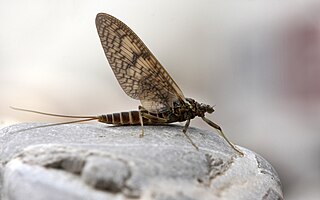
Mayflies are aquatic insects belonging to the order Ephemeroptera. This order is part of an ancient group of insects termed the Palaeoptera, which also contains dragonflies and damselflies. Over 3,000 species of mayfly are known worldwide, grouped into over 400 genera in 42 families.
The most recent understanding of the evolution of insects is based on studies of the following branches of science: molecular biology, insect morphology, paleontology, insect taxonomy, evolution, embryology, bioinformatics and scientific computing. It is estimated that the class of insects originated on Earth about 480 million years ago, in the Ordovician, at about the same time terrestrial plants appeared. Insects are thought to have evolved from a group of crustaceans. The first insects were landbound, but about 400 million years ago in the Devonian period one lineage of insects evolved flight, the first animals to do so. The oldest insect fossil has been proposed to be Rhyniognatha hirsti, estimated to be 400 million years old, but the insect identity of the fossil has been contested. Global climate conditions changed several times during the history of Earth, and along with it the diversity of insects. The Pterygotes underwent a major radiation in the Carboniferous while the Endopterygota underwent another major radiation in the Permian.

Baetidae is a family of mayflies with about 1000 described species in 110 genera distributed worldwide. These are among the smallest of mayflies, adults rarely exceeding 10 mm in length excluding the two long slender tails and sometimes much smaller, and members of the family are often referred to as small mayflies or small minnow mayflies. Most species have long oval forewings with very few cross veins but the hindwings are usually very small or even absent. The males often have very large eyes, shaped like turrets above the head.

The Heptageniidae are a family of mayflies with over 500 described species mainly distributed in the Holarctic, Oriental, and Afrotropical regions, and also present in the Central American Tropics and extreme northern South America. The group is sometimes referred to as flat-headed mayflies or stream mayflies. These are generally rather small mayflies with three long tails. The wings are usually clear with prominent venation although species with variegated wings are known. As in most mayflies, the males have large compound eyes, but not divided into upper and lower parts.

Siphlonurus lacustris is a species of mayfly belonging to the family Siphlonuridae. This species is present in most of Europe.

Coxoplectoptera or "chimera wings" is an extinct order of stem-group mayflies containing one family, Mickoleitiidae. Together with mayflies (Ephemeroptera), Coxoplectoptera are assigned to the clade Heptabranchia.

Baetoidea is a superfamily of mayflies, which probably includes the most primitive living species.
Georg Ulmer was a German entomologist who specialized in research of Trichoptera (caddisflies) and Ephemeroptera (mayflies).
Ameletus browni is a mayfly in the family Ameletidae, in the order Ephemeroptera ("mayflies"). A common name for Ameletus browni is "purple marram". Ameletus browni is found in North America. It is native to Canada and the Continental US.

Pisciforma is a suborder of mayflies in the order Ephemeroptera. There are at least 410 described species in Pisciforma.
Siphlonurus securifer is a species of primitive minnow mayfly in the family Siphlonuridae. It is found in North America.
Siphlonurus alternatus is a species of primitive minnow mayfly in the family Siphlonuridae. It is found in North America and Europe. In North America its range includes all of Canada, the northeastern United States, and Alaska.
Siphlonurus phyllis is a species of primitive minnow mayfly in the family Siphlonuridae. It is found in all of Canada and the northern United States.
Siphlonurus marshalli is a species of primitive minnow mayfly in the family Siphlonuridae. It is found in North America.

Siphlonurus occidentalis is a species of primitive minnow mayfly in the family Siphlonuridae. It is found in Central America to North America. In North America its range includes southwestern, northern Canada, all of Mexico, the western United States, and Alaska.
Siphlonurus typicus is a species of primitive minnow mayfly in the family Siphlonuridae. It is found in North America.
Siphlonurus rapidus is a species of primitive minnow mayfly in the family Siphlonuridae. It is found in North America.
Siphlonisca aerodromia, commonly known as the Tomah mayfly, is an extremely rare species and has only been documented less than 100 times. It was once thought to only known to occur in New York and Northern Maine, but has been since found more recently in eastern Canada as well. The Tomah mayfly is an endangered species and is listed as threatened in both New York and Maine. Its abundance is unknown. The Tomah mayfly is the only species within the monotypic genus Siphlonisca. The Tomah mayfly is a habitat specialist and an indicator species. Adults only live for a few days as they deposit eggs into rivers and streams. Nymphs hatch from eggs and migrate to the floodplains during springtime and following snow melt. They spend most of their lives in the floodplains, feeding on other aquatic invertebrates in order to grow rapidly. The Tomah mayfly was considered as a flagship species and led to the decision not to dam a stream and flood a sedge meadow and therefore conserve the ecosystem.
Jurassonurus is an extinct insect genus of mayflies (Ephemeroptera). This genus has only one member and that member has been scientifically named Jurassonurus amoenus which lived during the Middle Jurassic period 164.7 million to 155.7 million years ago in the Jiulongshan formation, Daohugou Village, Shantou Township, Ningcheng country, Inner mongolia, China.






